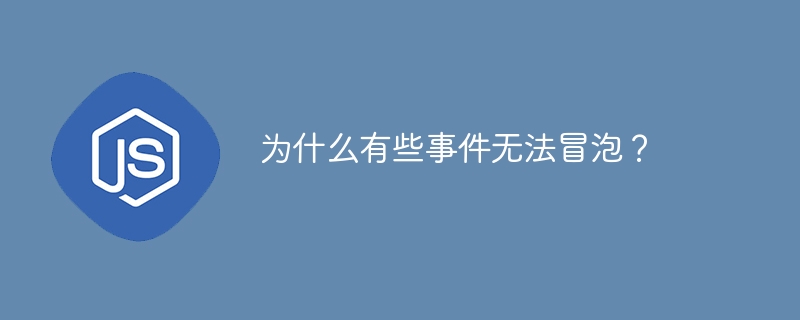

Why do some events fail to bubble?
In JavaScript, event bubbling is a common event handling mechanism. It means that when an element triggers an event, the event will be passed to its parent element and then bubble up in sequence. to ancestor elements until the document root element is reached. However, some events cannot bubble up, that is, they cannot be passed up according to the normal event flow. This article explores why this occurs and provides some concrete code examples.
1. Definition and reasons of non-bubbling events
Non-bubbling events (non-bubbling) refer to specific event types , when these events are triggered, the events are only processed on the element where they occur and will not be passed to superior elements.
The reasons why events cannot bubble up usually include the following:
(1) Event type: Some event types themselves It does not have bubbling functions, such as focus, blur, load, unload and other events.
(2) Attribute setting: Setting the attribute to false through the event processing function can prevent the event from bubbling.
(3) Special methods: Some special event processing methods, such as stopPropagation() and stopImmediatePropagation(), can prevent events from bubbling.
2. Examples of events that cannot bubble up
The following takes several common events that cannot bubble up as examples to explain their causes and how to use them:
focus and blur are focus events for input elements, they do not bubble. This is because when the user types in the text box, it makes the most sense to only have an effect on the currently focused element.
<input type="text" id="myInput">
<button id="myButton">Click me!</button>
<script>
document.getElementById('myInput').addEventListener('focus', function() {
console.log('Input element focused');
});
document.getElementById('myButton').addEventListener('focus', function() {
console.log('Button element focused');
});
</script>Output result: Input element focused
The load event is triggered after the page or an element is loaded, unload The event is triggered when the page or an element is unloaded. They also don't bubble up because these events are only relevant to the element being loaded or unloaded.
<div id="myDiv"></div>
<script>
document.getElementById('myDiv').addEventListener('load', function() {
console.log('Div element loaded');
});
</script>Output result: Div element loaded
The stopPropagation() method is used to prevent the bubbling of events. After using this method, the event will no longer be passed to the upper element.
<div id="parent">
<div id="child">
<button id="myButton">Click me!</button>
</div>
</div>
<script>
document.getElementById('parent').addEventListener('click', function() {
console.log('Parent clicked');
});
document.getElementById('child').addEventListener('click', function(e) {
e.stopPropagation();
console.log('Child clicked');
});
document.getElementById('myButton').addEventListener('click', function() {
console.log('Button clicked');
});
</script>Output result: Child clicked
As can be seen from the above example, when clicking on the child element button, the event is only triggered on the child element and will not risk as usual Bubble to the parent element.
3. Summary and Outlook
This article explores the reasons why some events cannot bubble up and provides specific code examples. By understanding the characteristics and causes of these events, we can better handle these events and use them flexibly in actual development. We hope that through the introduction of this article, readers can have a deeper understanding of the event bubbling mechanism and be able to use it flexibly in practice.
The above is the detailed content of Why do some events not have a bubbling mechanism?. For more information, please follow other related articles on the PHP Chinese website!




